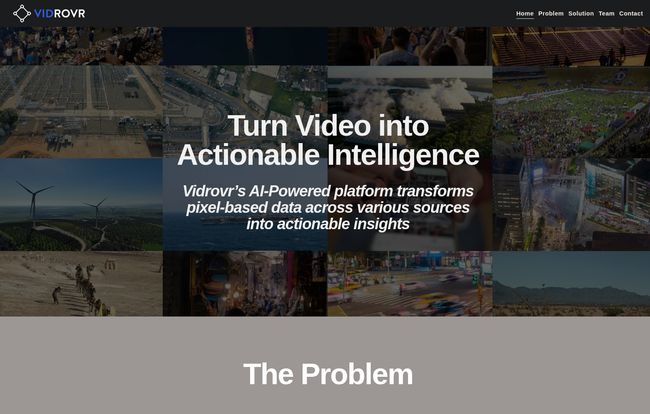Alright, let’s have a chat. If you’re in any field that deals with data—and let’s be honest, who isn’t these days?—you know the feeling. It’s like trying to take a sip of water from a firehose. The sheer volume of information coming at us is staggering. For years, I've been neck-deep in traffic generation and data trends, and I've seen countless tools promise to tame the beast. Some work, some... not so much.
But every now and then, something comes along that makes you lean in a little closer. Today, that something is a platform called Vidrovr.
Their headline is bold: “Turn Video into Actionable Intelligence.” It's a promise we've heard before, but the way they frame the problem hit home. They mention the Pentagon collecting over 22 terabytes of data from drones and other sources every single day. That’s not just a firehose; that’s a full-blown tsunami of pixels. And it’s a problem that’s only getting worse for intelligence and national security professionals.
The Real Problem Vidrovr is Trying to Solve
Before we get into the tech, let's just sit with that for a second. Imagine you're an analyst. Your job is to find the one critical moment in thousands of hours of video feeds. The needle in the haystack. Manually? It’s impossible. You're going to miss things. It's stressful, inefficient, and frankly, the delay can have serious real-world consequences. This isn't just about marketing analytics; it’s about mission success.
This is the core issue Vidrovr steps up to address. They’re not just offering another video player. They’re positioning themselves as an AI-powered intelligence platform designed to be the brain that can process this flood of visual information when a human one simply can’t keep up.
So What Exactly is Vidrovr?
At its heart, Vidrovr is a tool that teaches a computer to watch and understand visual data. We’re talking video, sure, but also imagery, geospatial data, and other pixel-based sources. It’s designed to sift through those terabytes automatically and surface what's actually important—the actionable insights.
Think of it like having a team of a thousand junior analysts who never sleep, never get bored, and can watch every single screen at once. Their only job is to flag the moments, objects, or patterns you’ve told them are important, freeing up the human experts (that’s you!) to do the actual thinking and decision-making.
This is where things get interesting. Vidrovr claims to be unrestricted in a few key ways that caught my eye.
Unrestricted by Place: The Cloud or The Battlefield
One of the first things that stood out to me was its operational flexibility. Vidrovr says it can run anywhere, from a massive cloud server to the “tactical edge.” That’s a term that gets thrown around a lot, but what it means is critical: it can work on-site, in the field, on a vehicle, or in a location with limited or no internet connection. This is a massive advantage for defense, disaster response, or remote industrial operations where sending data back to a central hub isn't practical. They do this with their patented Media Processing Pipeline (MPP), which sounds like the secret sauce that makes it all work.
Unrestricted by Scale: Bring On the Terabytes
The platform is also “agnostic to data volume.” I love that phrasing. It basically means it doesn't flinch at the size of your data problem. Whether you have a few hundred gigabytes or petabytes of footage, the architecture is built to handle it. This is a far cry from some tools I've tested that start to sputter and crash when you feed them a dataset that's even slightly larger than their demo files.

Visit Vidrovr
Unrestricted by Task: More Than Just Spotting Cats
This is the coolest part, in my opinion. Vidrovr isn’t just about identifying an object in a single frame. It offers sophisticated features like Object Tracking and Re-Identification (reID). What does that mean in plain English? It can spot a specific car, person, or object and then follow it across different camera feeds and over time. It can even create an “automated custody chain,” which is a fancy way of saying it logs every time and place the object of interest was seen.
Imagine the power of that. You could tell the system to “show me everywhere this specific blue truck appeared across the city’s traffic cameras in the last 24 hours.” The system could then stitch that journey together for you in minutes. That’s a game-changer.
The Not-So-Shiny Parts
Okay, I’m an optimist, but I’m also a realist. No tool is perfect, and it’s important to go in with eyes wide open. There are a couple of things about Vidrovr that give me pause.
Where's the Price Tag?
My biggest pet peeve. I went looking for their pricing page, and… poof. Nothing. Just a 404 “page not found” error. Now, this isn't uncommon for enterprise-grade, specialized B2B or B2G (Business-to-Government) software. The price likely depends heavily on the scale of deployment, the specific use case, and the level of support required. You’re not going to find a neat little table with “Basic, Pro, Enterprise” plans. You’ll have to contact them for a quote. Still, a little transparency would be nice, even if it’s just a starting range. Be prepared for it to be a significant investment.
It's Not Quite 'Plug and Play'
The other point is that this isn't a magic wand. One of the cons I dug up is that it “requires training models with mission-specific data.” This makes perfect sense. The AI needs to be taught what to look for in your unique context. If you want it to identify a specific type of industrial valve or a particular model of drone, you need to feed it examples. This means there’s an implementation and training phase. It's not a flaw in the product, just a reality of high-level AI work that potential users need to budget time and resources for. Don't expect to sign up and have it solving all your problems by lunchtime.
So, Who Should Be Calling Vidrovr?
This is clearly not a tool for your local vlogger trying to organize their footage. Vidrovr is built for high-stakes environments. We’re talking about:
- Intelligence Agencies and Defense Contractors: This is the obvious primary audience. Analyzing ISR (Intelligence, Surveillance, and Reconnaissance) data is their bread and butter.
- Law Enforcement and Public Safety: Sifting through city-wide CCTV footage or body-cam video.
- Large-Scale Industrial Operations: Monitoring vast facilities, pipelines, or remote sites for safety or maintenance issues.
- Geospatial Analysis Firms: Processing satellite and aerial imagery to detect changes or track assets over huge areas.
If your job title includes the word “analyst” and you regularly feel like you’re drowning in visual data, you’re the person Vidrovr wants to talk to.
FAQs About Vidrovr
- 1. What is Vidrovr in simple terms?
- Vidrovr is an advanced AI platform that automatically watches and analyzes massive amounts of video and image data to find important events, objects, or patterns, so humans don't have to do it manually.
- 2. What kind of data can it process?
- It's designed to handle a wide range of pixel-based data, including standard video, full-motion video (FMV), aerial imagery, and geospatial data. It’s also built to handle huge volumes, from gigabytes to terabytes.
- 3. Is Vidrovr easy to set up?
- Not exactly. It’s a powerful, specialized tool that requires its AI models to be trained on your specific data to be effective. Expect an implementation and training period; it's not a simple plug-and-play software.
- 4. How much does Vidrovr cost?
- The pricing isn't publicly available on their website. This is typical for enterprise-level platforms, as the cost will depend on your specific needs, data volume, and deployment type (cloud vs. on-site). You'll need to contact their sales team for a custom quote.
- 5. Can it track an object across multiple cameras?
- Yes, this is one of its key features, known as Object Tracking and Re-Identification (reID). It can identify an object of interest and then track its movement across different video feeds and over a period of time.
Final Thoughts
Look, the world is only going to create more data, not less. The floodgates are open, and they're not closing. Tools like Vidrovr represent the future of how we manage this reality. Instead of trying to hire more people to watch more screens—a losing battle—they leverage AI to do the heavy lifting.
While the lack of transparent pricing and the need for model training are important considerations, the core value proposition is incredibly strong. For the right organization, Vidrovr could be the difference between being overwhelmed by data and being empowered by it. It’s a specialized tool for a specialized, and very difficult, problem. And from where I'm sitting, it looks like a very capable solution.



